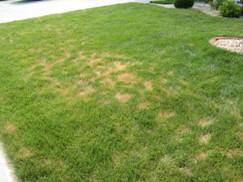Part I: Too hot: Why some turfgrass species look poor in summer.
There are multiple causes for turf decline in the summer. Cool-season turf areas can decline in the summer because of high temperatures, drought, pest damage (insects, diseases, weeds, others), and due to mismanagement. The general symptoms for many of these causes are usually brown turf (Figures 1-8).
Temperatures:
Cool-season grasses (creeping bentgrass, fine fescues, Kentucky bluegrass, perennial ryegrass, tall fescue, and others) have optimal photosynthesis (energy production) from 68 °F to 77 °F. Cool-season grasses can photosynthesize below 68 °F or above 77 °F although the rate of photosynthesis decreases. Respiration is another process that cool-season grasses use to release the energy made during photosynthesis. Respiration is a key process in the growth, maintenance, metabolism, and nutrient uptake. One last process that is important to understand is photorespiration. During warm weather (especially temperatures > 87 °F) cool-season grasses have trouble capturing carbon dioxide (CO2) from the air and instead capture oxygen (O2) leading to a process called photorespiration. When photorespiration occurs instead of photosynthesis the plant uses energy instead of making energy. In short, cool-season grasses don’t make energy well when it is hot out and as a results they don’t grow (roots or shoots) well in hot weather which can lead to a decline in turf quality.
Drought (water):
Water is critical to the growth of all plants, not just turfgrass. Water is a key part of photosynthesis and respiration reactions as well as many other plant metabolic activities. Turfgrass leaves and shoots are comprised of about 80% water. A lack or water (rainfall or irrigation) will lead to a decrease in growth due to a decrease in photosynthesis and plant respiration and an increase in plant temperature (lack of transpirational cooling; analogous to humans not being able to sweat).
Each turf species responds to drought differently. Some grasses such as Kentucky bluegrass enter a summer dormancy when soils begin to dry. Summer dormancy is a process where the plant stops growth and turns brown (dormant) but it is not dead. When rainfall returns following drought, Kentucky bluegrass will emerge from summer dormancy and resume normal growth. Other turfgrasses such as tall fescue and perennial ryegrass maintain turf vigor (green growth) during drought and avoid dormancy. Various mechanisms allow turfgrasses to maintain vigor during drought but growing deeper or larger roots is the most advantageous as this allows turf to fully utilize available soil moisture and prolong the need for irrigation or rainfall. Even if drought tolerant species are utilized, turfgrasses can experience drought injury in the summer, especially where irrigation is not available, on southern slopes, and on shallow or compacted soils.
Pests:
Various pests attack turf in the summer or attack the turf in the spring and symptoms may appear during the summer. Parts II, III, and IV of this special summer series will address the disease, weed, and insect pests that are problematic in summer.
Mismanagement:
Lastly, there are a few man-made causes of summer decline to turf areas. These could include but are not limited to:
-
Improper irrigation distribution
-
Lack of irrigation to newly planted turf
-
Shallow rooted areas that receive light frequent irrigations instead of deep and infrequent irrigation
-
Too low of a mowing height resulting in shallow roots
-
Lack of cultural practices such as aerification to alleviate soil compaction
-
Poor soil drainage
-
Application of herbicides when the soil is dry or temperatures exceed 85 °F
-
Mowing turf when wilted or under drought stress
-
Over-application of nitrogen fertilizers stimulating shoot growth instead of root growth
-
Application of nitrogen fertilizers with high burn potential (such as quick release fertilizers) during periods of high heat and humidity
-
Planting the wrong grass in the wrong place
|
|
|
|
|
|
|
|







